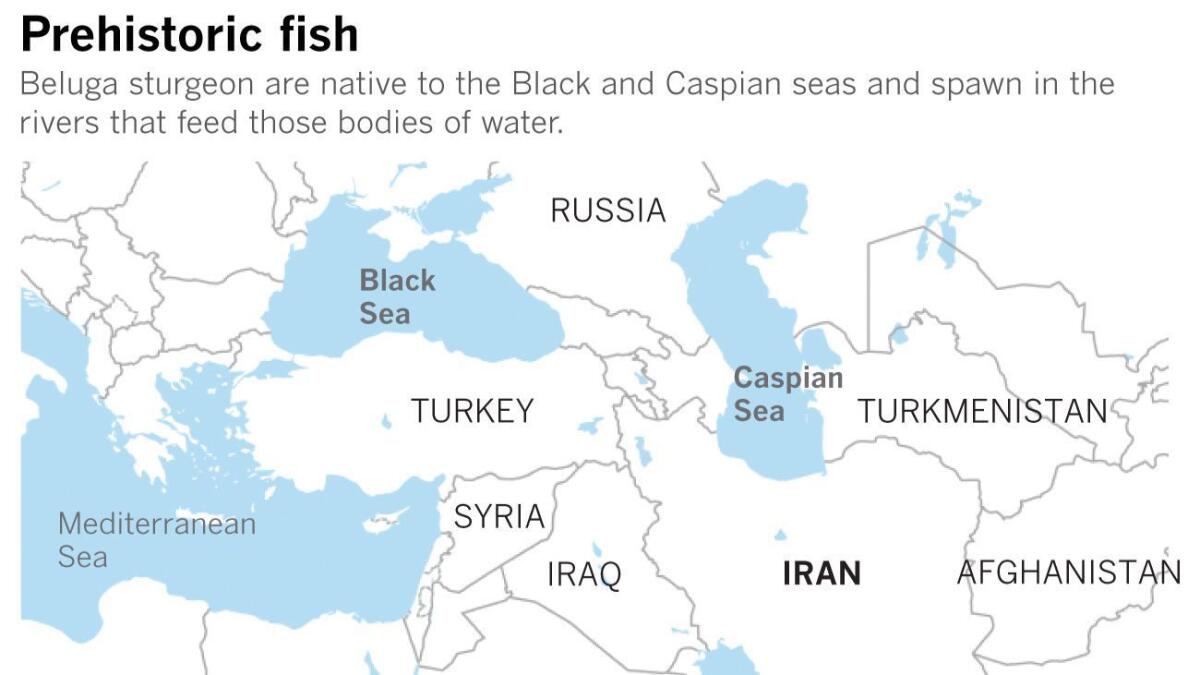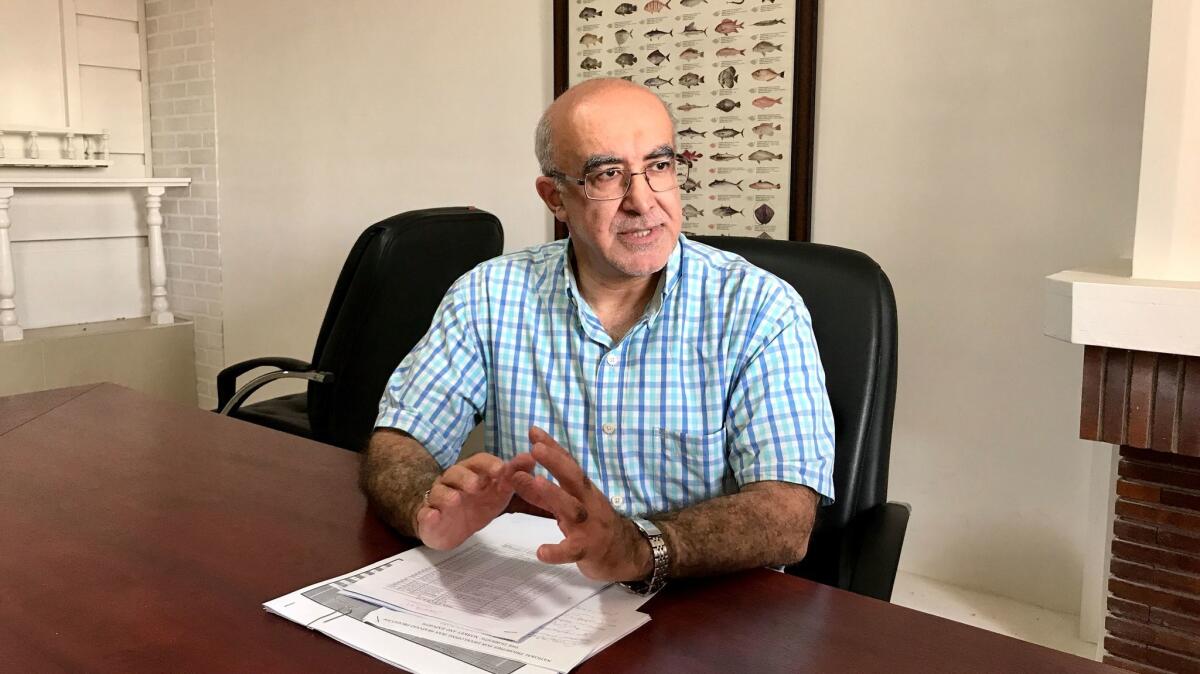At $80 an ounce, it’s not for everyone. But Iranian caviar is eyeing a comeback in the U.S.

- Share via
Reporting from TEHRAN — Nasser Meshkin Azarian took a careful nibble, letting the salty, grainy texture roll across his tongue. He smiled and washed it down with a sip of cool water.
“I give it an 82 or 83” out of 100, Azarian said. At the retail price of $80 an ounce in Iran, it was an expensive bite. But beluga caviar is for discerning palates.
“Iranian caviar has a fantastic reputation all around the world,” said Azarian, the chairman of Bahoo Caviar, a distributor in Tehran. “It is only going to grow.”
As Iran’s economy tries to rebound from years of harsh international sanctions, producers of black caviar — that salt-cured delicacy associated with the rich and famous, with a price tag to match — are also eyeing a comeback.
Once among Iran’s most famous exports, the industry nearly collapsed because of trade restrictions and an international clampdown on the capture of sturgeon from the Caspian Sea. The long, prehistoric fish, whose glittery, bead-like eggs make the choicest caviar, had been driven nearly to extinction by overfishing.

Now, dozens of Iranian producers are raising sturgeon legally on fish farms, just as the 2015 nuclear agreement Iran signed with six world powers has slowly reopened foreign markets to Iranian products.
After the United States lifted an embargo on Iranian goods in January 2016, the first shipment of Iranian caviar in nearly a decade reached the U.S. last year: a modest 18 pounds of the prized beluga variety, some of which ended up for sale at stores frequented by Iranian expatriates in Los Angeles and other cities.
The shipment was worth about $16,000 before retail markup, or about as much as Iran’s $41 billion oil and gas industry generates in 12 seconds. Caviar alone, no matter how costly, is not going to resuscitate Iran’s moribund economy.
But the shipment was one signal of a new page in Iran’s relations with the West, and a sign that the Islamic Republic was ready to do business with the world again. In two or three years, industry officials said, Iran could export as much as 200 pounds annually to the United States as production increases and Iran finds new customers for the luxury food.
“The United States is an uncharted but potentially big market for us,” said Ali Akbar Khodaei, secretary-general of Iran’s Fisheries Production and Trading Union, an industry group.
For many, Iranian caviar is associated with the era before the 1979 Islamic Revolution, when a Western-friendly monarchy ruled the country and European tastes were in vogue.
The high-living former monarch, Mohammed Reza Shah Pahlavi, was famed for lavish dinners where he would ply foreign dignitaries with mounds of nutty, buttery black caviar from the Caspian. (He, however, was allergic to the eggs.) At a three-day extravaganza in 1971 to mark 2,500 years of the Iranian dynasty, where pastry chefs and chandelier makers were flown in from France, the shah reportedly served 330 pounds of Caspian caviar.
Such over-the-top decadence was one of the sparks for the revolution, and Iran’s new, austerity-minded Islamic rulers set about eliminating whatever reeked of continental luxury. Caviar was temporarily banned as un-Islamic, then reinstated, but never regained favor as the mullahs showed little interest in developing any export apart from oil.

With the economy still floundering nearly two years after the lifting of nuclear-related sanctions, many economists say Iran’s leaders need to find ways to produce more exports to create jobs and bring in foreign currency.
There is potential in Iran’s fisheries industry, whose exports rose 80% in the most recent quarter, compared with the same period a year ago, said Djavad Salehi-Isfahani, an economics professor at Virginia Tech University.
“Caviar is a symbol of good times, of a ‘civilized’ Iran that is friendly to the West,” Salehi-Isfahani said. “I would say that image is a mirage. But in terms of generating employment, such exports are important. Fisheries are very labor intensive compared to oil and petrochemicals. If there is movement there, it’s a sign for policymakers that promoting such exports is a good thing.”
The lifting of sanctions is happening at a potentially lucrative time for Iran’s caviar industry, which is finally rebounding after decades of struggles.
The mostly state-controlled industry nearly collapsed during the 1990s and 2000s as the breakup of the Soviet Union — with which Iran shared the Caspian Sea — triggered a torrent of unregulated fishing in one of the world’s main habitats for several sturgeon species including the beluga, which produces the most expensive caviar.
In 2005, with data showing the sea’s sturgeon population had declined by 90%, the United States, then the world’s No. 1 buyer of beluga caviar, banned the import of beluga products from the Caspian. A few years later, all U.S. trade with Iran ceased as unilateral and global sanctions were tightened to punish the Islamic Republic for failing to stop its illicit nuclear program.
Then, in 2010, sturgeon farming got a boost after Iran signed a ban on sturgeon fishing with Russia and the three other former Soviet republics that are part of the Caspian Sea basin. Iran supplied several fish farms with sturgeon from government stocks, allowing the beluga to grow in concrete pools, some with salt water piped in from the Caspian.
The beluga, with a lifespan of 100 years, typically takes about a decade to begin producing eggs. Within two or three years, industry officials say, Iranian farmed caviar production will rise exponentially.

“We are free from sanctions at the same time as Iranian caviar is ready to be reintroduced to the world market,” Khodaei said. “It is a great opportunity.”
But challenges remain. U.S. financial sanctions against Iran — stemming from its ballistic missile program and support for militant groups — still bar Iranian companies from doing business in dollars, meaning sales to the United States must be done through informal money transfer systems. That is manageable for relatively small shipments such as caviar, but potentially problematic if volumes rise substantially.
And many producers worry that the Trump administration’s hostility toward Iran will result in the United States withdrawing from the nuclear deal and leveling fresh sanctions that could again isolate Iranian companies from world markets.
“We don’t like this rhetoric from Mr. Trump — it’s worrisome to us,” Khodaei said. “Before the nuclear-related sanctions were imposed, we had relations with buyers around the world. We have lost ground because of collective punishment inflicted on the Iranian people, for a crime we have nothing to do with.”
In recent years, China has accounted for much of the world’s caviar production, although its product is widely seen as inferior to Iranian and Russian eggs. Farms in California also have begun to produce black caviar.
But Iranian producers are confident that their caviar will regain customers in the United States — and not just among Iranian expatriates nostalgic for a taste of home.
“Iranians around the world have memories of eating caviar, but in the long term we need to find new clients as well,” Azarian said, sliding a plate of beluga-topped toasts in the direction of his American visitor.
Mostaghim is a special correspondent.
Follow @SBengali on Twitter
More to Read
Sign up for Essential California
The most important California stories and recommendations in your inbox every morning.
You may occasionally receive promotional content from the Los Angeles Times.











